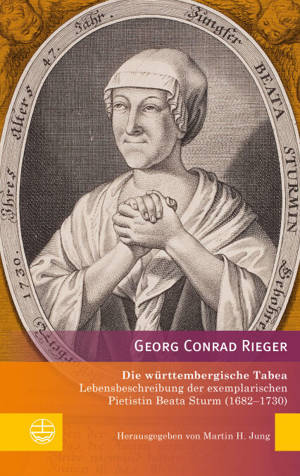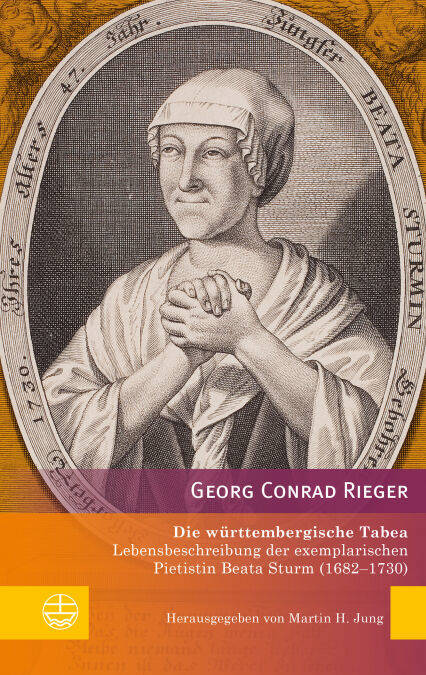
- Retrait gratuit dans votre magasin Club
- 7.000.000 titres dans notre catalogue
- Payer en toute sécurité
- Toujours un magasin près de chez vous
- Retrait gratuit dans votre magasin Club
- 7.000.0000 titres dans notre catalogue
- Payer en toute sécurité
- Toujours un magasin près de chez vous
Die württembergische Tabea EBOOK
Lebensbeschreibung der exemplarischen Pietistin Beata Sturm (1682‒1730)
Georg Conrad Rieger
24,99 €
+ 24 points
Description
Eine sehbehinderte Frau, die ihre Hände zum Beten faltet – so präsentiert der Hofmaler Isaak Lieffkopf die zum württembergischen Pietismus zählende Stuttgarter Juristentochter Beata Sturm (1682– 1730). Und ihr Biograph Georg Conrad Rieger (1687‒1743) gibt mit seiner Titelformulierung, in der er die Frau mit der aus dem Neuen Testament bekannten Tabea oder Tabita (Apg 9) vergleicht, zu erkennen, wer sie eigentlich war: eine Jüngerin Jesu, die viele gute Werke tat und an der die Krankheit und Tod besiegende Macht Gottes sichtbar wurde.
Am liebsten wäre sie "Prediger" geworden, bekannte Beata Sturm ihrem Seelsorger Rieger. Gleich nach ihrem Tod begann er ihre Biographie zu schreiben. In Württemberg wurde "Jungfer Sturmin" nach ihrem Tod wie eine Heilige verehrt, und Rieger bemüht sich in seiner auf persönlichen Kenntnissen beruhenden Biographie, ihr Leben und Wirken so zu schildern, dass sie möglichst vielen zum Vorbild werden konnte. Sein Buch ist ein Beispiel evangelischer Hagiographie und gibt aber zeitgenössische Einblicke in die Frömmigkeits- und Lebenspraxis des frühen 18. Jahrhunderts.
[The Württembergian Tabea. Biography of the exemplary pietist Beata Sturm (1682–1730)]
A woman, weak of vision, folding her hands in prayer – this is how the court painter Isaak Lieffkopf depicted the pietist Beata Sturm (1682–1730) from Stuttgart. In the title of his book her biographer Georg Conrad Rieger (1687–1743) compares her to the woman Tabitha (Acts 9) from the New Testament, thus indicating who she actually was: a disciple of Jesus, who did much good, gave many alms and in whom God's power over illness and death was demonstrated.
Beata Sturm confessed to Rieger, her pastoral counsellor, that she would have preferred to become a "preacher". Shortly after her death, Rieger started to write her biography. In Württemberg, "maid Sturmin" was worshipped like a saint after her death. Similarly, in his biography that contains personal knowledge of Beata Sturm, Rieger aims to depict her life and work in a way that she could become a role model for many. His book is an example of a Protestant hagiography, but also includes contemporal insights into the practice of piety in the life in the early 18th century.
Martin H. Jung is Professor of Historical Theology at the University of Osnabrück. Since 1999 he is a member of the Historical Commission for the Study of Pietism. The exploration of pietism in Württemberg has been one of his main research subjects since his PhD.
Am liebsten wäre sie "Prediger" geworden, bekannte Beata Sturm ihrem Seelsorger Rieger. Gleich nach ihrem Tod begann er ihre Biographie zu schreiben. In Württemberg wurde "Jungfer Sturmin" nach ihrem Tod wie eine Heilige verehrt, und Rieger bemüht sich in seiner auf persönlichen Kenntnissen beruhenden Biographie, ihr Leben und Wirken so zu schildern, dass sie möglichst vielen zum Vorbild werden konnte. Sein Buch ist ein Beispiel evangelischer Hagiographie und gibt aber zeitgenössische Einblicke in die Frömmigkeits- und Lebenspraxis des frühen 18. Jahrhunderts.
[The Württembergian Tabea. Biography of the exemplary pietist Beata Sturm (1682–1730)]
A woman, weak of vision, folding her hands in prayer – this is how the court painter Isaak Lieffkopf depicted the pietist Beata Sturm (1682–1730) from Stuttgart. In the title of his book her biographer Georg Conrad Rieger (1687–1743) compares her to the woman Tabitha (Acts 9) from the New Testament, thus indicating who she actually was: a disciple of Jesus, who did much good, gave many alms and in whom God's power over illness and death was demonstrated.
Beata Sturm confessed to Rieger, her pastoral counsellor, that she would have preferred to become a "preacher". Shortly after her death, Rieger started to write her biography. In Württemberg, "maid Sturmin" was worshipped like a saint after her death. Similarly, in his biography that contains personal knowledge of Beata Sturm, Rieger aims to depict her life and work in a way that she could become a role model for many. His book is an example of a Protestant hagiography, but also includes contemporal insights into the practice of piety in the life in the early 18th century.
Martin H. Jung is Professor of Historical Theology at the University of Osnabrück. Since 1999 he is a member of the Historical Commission for the Study of Pietism. The exploration of pietism in Württemberg has been one of his main research subjects since his PhD.
Spécifications
Parties prenantes
- Auteur(s) :
- Editeur:
Contenu
- Nombre de pages :
- 280
- Langue:
- Allemand
- Collection :
Caractéristiques
- EAN:
- 9783374066780
- Date de parution :
- 31-10-20
- Format:
- Ebook
- Protection digitale:
- Digital watermarking
- Format numérique:

Les avis
Nous publions uniquement les avis qui respectent les conditions requises. Consultez nos conditions pour les avis.






